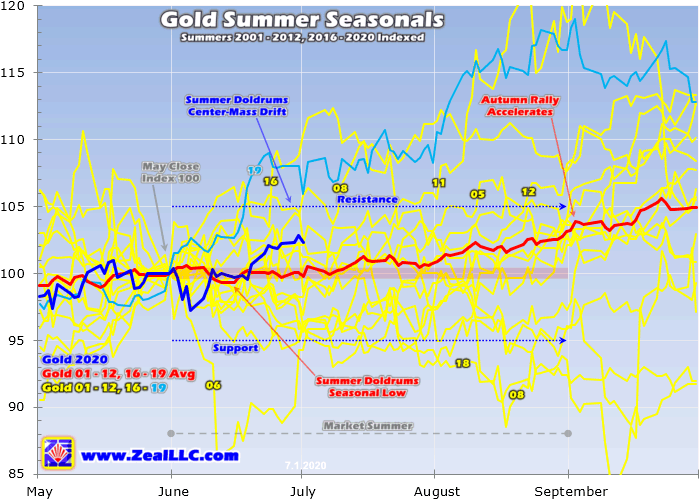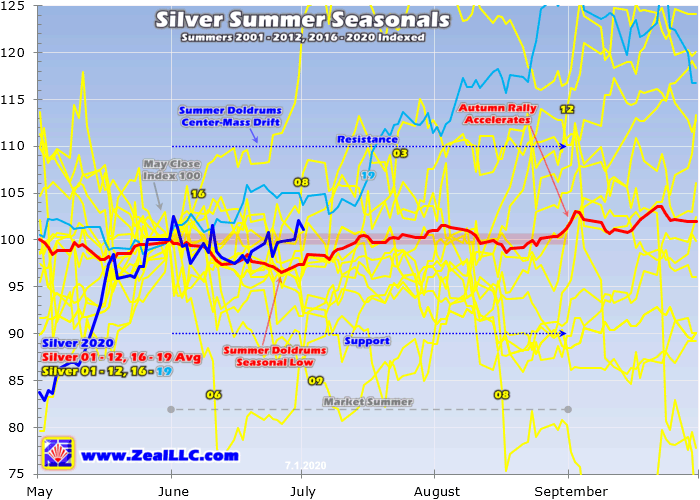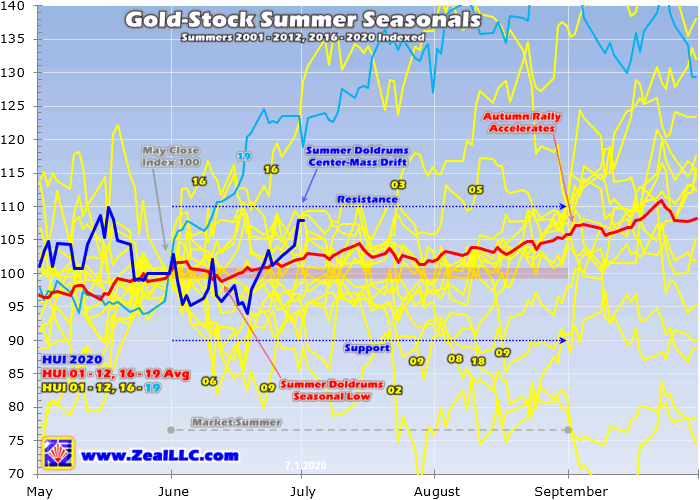Gold and Silver Seasonal Trend Analysis / Commodities / Gold & Silver 2020
Gold, silver, and theirminers’ stocks suffer their weakest seasonals of the year in early summers. With traders’ attention normally diverted to vacationsand summer fun, interest in and demand for precious metals usually wane. Without outsized investment demand, goldtends to drift sideways dragging silver and miners’ stocks with it. Feared as the summer doldrums, sometimes unusualcatalysts short-circuit them.
This doldrums term is very apt for gold’s summerpredicament. It describes a zone in theworld’s oceans surrounding the equator. There hot air is constantly rising, creating long-lived low-pressureareas. They are often calm, with littleor no prevailing winds. History is fullof accounts of sailing ships getting trapped in this zone for days or weeks,unable to make headway. The doldrumswere murder on ships’ morale.
Crews had no idea whenthe winds would pick up again, while they continued burning through their limitedstores of food and drink. Without movingair, the stifling heat and humidity were suffocating on these ships long beforeair conditioning. Misery and boredomwere extreme, leading to fights breaking out and occasional mutinies. Being trapped in the doldrums was viewed withdread, it was a very trying experience.
Gold investors cansomewhat relate. Like clockwork headinginto most summers, gold starts driftinglistlessly sideways. It often can’tmake significant progress no matter what trends looked like heading into June,July, and August. As the days and weeksslowly pass, sentiment deteriorates markedly. Patience is gradually exhausted, supplanted with deep frustration. Plenty of traders capitulate, abandoningship.
June and Julies inparticular are often desolate sentiment wastelands for the precious metals,devoid of recurring seasonal demand surges. Unlike most of the rest of the year, the summer months simply lack anymajor income-cycle or cultural drivers of outsized gold investment demand. Summer 2019 proved an exception on a major gold-bullbreakout, and summer 2020 is looking like another on extreme Fed moneyprinting.
Quantifying gold’ssummer seasonal tendencies during bull markets requires all relevant years’ priceaction to be recast in perfectly-comparable percentage terms. That is accomplished by individually indexing each calendar year’s gold price to its lastclose before market summers, which is May’s final trading day. That is set at 100, then all gold-priceaction each summer is recalculated off that common indexed baseline.
So gold trading at anindexed level of 105 simply means it has rallied 5% from May’s final close,while 95 shows it is down 5%. Thismethodology renders all bull-market-year gold summers in like terms. That’s necessarysince gold’s price range has been so vast, from $257 in April 2001 to $1894 inAugust 2011. That span encompassedgold’s last secular bull, which enjoyed a colossal 638.2% gain over those 10.4 years!
While that mighty goldbull ran from 2001 to 2011, 2012 was technically a bull year too since a 20%+drop back into formal bear territory wasn’t yet seen. That finally came in Q2’13, where goldplummeted 22.8% in its worst quarterly performance in 93 years. The Fed’s unprecedented open-ended QE3 campaignwas ramping to full speed, levitatingstock markets which slaughtered demand for alternative investments led bygold.
The resulting gold-bearyears ran from 2013 to 2015, which need to be excluded since gold behaves verydifferently in bull and bear markets. Thatultimately pounded gold to a 6.1-year secular low in December 2015, whichhelped birth today’s gold bull. It hasgradually powered higher on balance ever since, never suffering anybull-slaying 20%+ selloffs. So 2016 to 2020have proven gold-bull years to add into this analysis.
When all gold’s summerprice action from these modern gold-bull years is individually indexed andthrown into a single chart, this spilled-spaghetti mess is the result. 2001 to 2012 and 2016 to 2018 are rendered inyellow. Last summer’s action is shown inlight blue for easier comparison with this summer. Seeing all this perfectly-comparable indexedsummer price action at once reveals gold’s center-mass-drift tendency.
These summer seasonalsare further refined by averaging together all 16 of these gold-bull years intothe red line. Finally gold’ssummer-to-date action this year is superimposed over everything else in darkblue, showing how gold is performing compared to its seasonal mean. So far in summer 2020 gold has beenmeandering roughly in line with seasonal expectations, although a couple bigcatalysts could change that.

While there are outlieryears, gold generally drifts listlessly in the summer doldrums much like asailing ship trapped near the equator. Thecenter-mass-drift trend is crystal-clear in this chart. The vast majority of the time in June, July,and August, gold simply meanders between 5% from May’s final close. This year that equates to a probable summer rangebetween $1645 to $1818. Gold tends to remainwithin trend.
Interestingly “goldsummer doldrums” is increasingly a misnomer as more gold-bull years slowly reshapethe seasonal average. Gold’s summerseasonal low statistically has been gradually pushed all the way back tomid-June. On June’s 11th trading day,which translated to June 15th this summer, gold has tended to carve its summerseasonal low. The worst of gold’s weak seasonalspass quickly in early summers!
At that mid-June nadir,gold has only been down an average of 0.7% from May’s close. From there this metal actually tends to startclimbing again into July and especially August. In average indexed terms, gold has tended to eke out 0.1% gains in Junes. They’re the real doldrums. Gold’s momentum starts building to 0.7% gainsin Julies, then really accelerates into summer-ends with hefty 2.3% gains inAugusts!
Between that averageseasonal low in mid-June and the end of August, gold has averaged impressive 3.8%summer rallies in these modern bull-market years. The summer doldrums have been compressed intoa shorter time frame by a couple outlier years in today’s secular goldbull. They are its maiden 2016 summerand last summer. Those gold outperformancesprove that catalysts can fuel counter-seasonal demand.
Summer 2016 was thisgold bull’s first, where gold enjoyed strong upside price momentum and bullishpsychology heading into the summer doldrums. Investors love chasing winners, and kept on piling into gold asit carved major new secular highs. Byearly July, gold had soared 12.3% summer-to-date! But that left gold super-overbought so thosegains faded, yet this metal still surged 7.7% in that whole summer.
Gold bucked the summerdoldrums in 2016 because gold investment demand was exceptionally strong. Several weeks ago I wrote an essay explainingwhy the best daily proxy for global gold investment is the physical-gold-bullion holdings of the leading and dominant American GLD SPDR Gold Shares gold ETF. When stock investors are flooding into goldvia GLD shares chasing momentum, their buying forces gold higher.
Gold blasted up 12.3% fromthe end of May into early July 2016 because American stock investors werebuying GLD shares much faster than gold itself was being bought. Their differential demand forced GLD’sholdings 13.1% higher in roughly that same early-summer span. Out of 24 summer trading days into earlyJuly, 18 saw GLD-holdings builds averaging a sizable 0.7% each! Investment capital was pouring in.
Gold ETFs like GLD andthe American IAU iShares Gold Trust, the second-largest gold ETF in the worldafter GLD, are designed to track the gold price. This is only achievable if they shunt all excessETF-share demand and supply into the underlying world gold market. When gold-ETF shares are being bought fasterthan gold, ETF-share prices threaten to decouple from gold to the upside andfail their tracking mission.
So gold-ETF managers mustoffset excess demand by issuing enough new gold-ETF shares. Then they use the proceeds from these salesto buy more physical gold bullion to hold in trust for their shareholders. So when gold-ETF holdings are rising, itshows stock-market capital is flowing into gold. While that is unusual during market summers, itdoes happen if gold enjoys a sufficient catalyst to attract investors’ interest.
Summer 2019 provedanother great example of this. Afterthat initial investment-fueled bull-market peak in early-July 2016, gold failedto climb to more new bull-market highs for several years. But late last June, gold finally managed its next decisive bull-market breakout after dovish Fed interest-rate projections hammered the US dollar. The resulting new gold-bull highs reallyexcited investors, who piled in to chase the upside.
So last summer as thelight-blue line shows, gold rocketed 16.7% higher in one of its best performancesout of all gold-bull summers! Investorsflooded into gold because it was rallying fast, enticing in even more investmentcapital in an awesome virtuous circle of buying. Again summer 2019’s counter-seasonal gold investmentdemand was evident in GLD’s holdings. They soared a massive 18.2% higher last summer!
And gold’s upsidepotential this summer is far greater than normal due to this samemomentum-chasing investment phenomenon. Gold investment soared after mid-March’s stunning stock panic on the dire economic impact of governments’draconian lockdowns to slow the spread of COVID-19. That drove gold to major new bull-market highschallenging $1750 by late May. So investorspiled in to ride gold’s big gains.
The major gold ETFs continuedto enjoy strong differential share demand in June, with GLD and IAU seeingmajor holdings builds of 5.0% and 3.2% last month! That came during one of gold’s weakest monthsseasonally, and is likely to grow as gold strengthens in July and August. Gold being driven to new highs by investmentdemand is self-feeding, the higher gold rallies the more investors want to buy toparticipate.
And it’s not just therapidly-improving seasonals in July and August that bode well for gold. This summer has a couple of unusual catalystswhich ought to spawn outsized investment demand. The first and most-important is the Fed’s radically-unprecedentedextreme monetary inflation unleashed to goose stock markets out of their deep paniclows. The Fed feared the resulting negativewealth effect would spawn a depression.
So between mid-March toearly June, the Fed’s balance sheet skyrocketed 66.2% higher in just 2.8months! That blasted the US-dollar supplyan astounding $2,853.3b higher. With 2/3rdsmore dollars just conjured out of thin air to bid up prevailing price levels onshrinking pools of goods and services, there’s never been a more-important timeto own gold. Prudent investors are buyingwith that inflation tsunami hitting.
Gold investment demandalso surges when stock markets are weakening or expected to weaken. Gold is the ultimate portfolio diversifiersince it is negatively correlated with material stock selloffs. So as what looks like a monster bear rally in US stocks driven by the Fed’s near-hyperinflation inevitably rolls over,gold investment demand should strengthen considerably. Gold has a very-bullish setup in this summerof 2020!
For many years I’vethrown in silver and the gold miners’ stocks in my gold-summer-doldrumsanalyses. Gold’s fortunes drive the entireprecious-metals complex. Silver and precious-metalsminers’ stocks are effectively leveraged plays on gold. Their summer behavior mirrors and amplifieswhatever is happening in gold. So if goldenjoys outsized gains this summer, silver and their miners’ stocks ought to doeven better.

This silver-summer-seasonalsmethodology is the same as gold’s, showing how it has fared during gold’smodern bull-market years. With a far-smallerglobal market, silver is much-more volatile than gold. So its center-mass summer drift is wider, running10% from May’s final close. That impliesa summer range between $16.04 to $19.60 this year. But silver’s summer seasonals have provenweaker overall than gold’s.
Silver’s summer-doldrumsseasonal low tends to arrive a couple weeks after gold’s in late June. That is averaging June’s 20th trading day,which translated to June 26th this year. And that saw silver being down 3.5% summer-to-date, much worse than gold’s0.7% average droop at its own summer seasonal low. Silver’s overall seasonal performance inmarket summers is considerably worse than gold’s too.
On average in 2001 to2012 and 2016 to 2019, silver merely edged up 1.3% between the end of May tothe end of August. That is dwarfed by gold’sfar-superior 3.1%! Silver’s bigrelative underperformance in summers is likely sentiment-related. Investors usually don’t flock to silverunless gold itself is running in an exciting and noticeable way. And gold’s average gradual summer rallies don’tusually rise to that standard.
When gold enjoyedoutsized summer surges like in those summers of 2016 and 2019, silver respondedwith great 16.8% and 25.8% summer rallies! But when gold just grinds modestly higher like summer 2017’s 4.2% gain,that doesn’t garner enough investor attention for silver to amplify its upside. That year the white metal lagged with a little1.4% summer gain. Silver needs biggold uplegs to entice major capital inflows.
Thankfully the goldstocks aren’t so picky, tending to leverage gold’s summer gains whether theyprove big and outsized or small and uninspiring. For gold-stock summer seasonals, I’m usingthe older HUI gold-stock index which closely mirrors the GDX VanEck Vectors Gold MinersETF more popular today. Since GDXwas only launched in May 2006, it has insufficient price history to match thesemodern gold-bull years.

This same summer-seasonalitymethodology applied to the HUI shows gold stocks track and amplify gold’sfortunes far better than silver. The more-volatilegold stocks also have a wider center-mass-drift summer trading range of 10%from May’s final close. In HUI termsthat runs from 246.0 to 300.7 this year. Applied to GDX, that equates to a likely summer-2020 trading rangerunning from $30.89 to $37.75.
Interestingly goldstocks’ average summer-doldrums low is on June’s 10th trading day, which shookout to June 12th this year. That is rightin line with gold’s own summer seasonal low. The gold stocks per the HUI tend to slump 1.3% by then from May’s close,which amplifies gold’s early-summer weakness by 1.9x. The major gold stocks of theHUI and GDX generally tend to leverage material gold moves by 2x to 3x.
On average from 2001 to2012 and 2016 to 2019, the gold stocks have rallied 2.0% in Junes, slumped 0.3%in Julies, and then finished summers strong with big 4.0% surges inAugusts. This compares to +0.1%, +0.7%,and +2.3% for gold in these same market-summer months. Overall from the end of May to the end ofAugust, the HUI has averaged 5.8% summer gains. That’s again 1.9x gold’s 3.1% mean rally.
Like silver to a lesserextent, the gold stocks fare best during market summers when gold is surgingfast enough to generate excitement. That entices traders enjoying summers’ many pleasures back to markets tobuy in and chase those gains. During gold’soutperforming summers of 2016 and 2019 driven by that strong investment demand,the HUI rallied 10.1% and a massive 45.3% on gold’s 7.7% and 16.7% gains!
That made for 1.3x and2.7x upside leverage to gold in those summers of 2016 and 2019. The latter is excellent, showing howimportant it is to own gold miners when gold is enjoying counter-seasonal strongsummer investment demand. The former isonly light because gold and thus gold stocks peaked in mid-summer 2016 beforeslumping into its end. By early August2016, the HUI had soared 41.4% summer-to-date!
That made forfar-more-impressive 3.4x amplification of gold’s summer surge by its miners’stocks. The gold stocks have generallyperformed fairly well during modern gold-bull summers. They’ve enjoyed a solid average summer rally seasonally,but surge dramatically when gold is being bid higher by strong investment demand. So the gold summer doldrums usually don’tlive up to their fearsome reputation.
These weak gold seasonalsdon’t encompass entire market summers, but have been compressed into earlyJunes on average. From those mid-monthseasonal lows, gold and the gold stocks tend to start marching higher intosummer-ends leading into their big autumn rallies. Silver isn’t as responsive, but still followsthis seasonal pattern to a lesser extent. Summer seasonal weakness in precious metals is usually modest.
And summer 2020 hasgood potential for outsized gold gains again. Following March 2020’s brutal stock panic and subsequent crazy-extremeFed money printing, gold investment demand proved very strong leading intosummer. And it has remained strong throughits first third, or June. So it’s probablya decent time to add to positions in fundamentally-superior gold and silverminers’ stocks if you aren’t sufficiently deployed.
At Zeal we started aggressivelybuying and recommending fundamentally-superior gold and silver miners in our weekly and monthly subscriptionnewsletters back in mid-March right after the stock-panic lows. We’ve been layering into new positions eversince, with unrealized gains already growing huge. Today our trading books are full of these fundamentally-thrivinggold and silver miners that aren’t done running yet.
To profitably trade high-potentialgold stocks, you need to stay informed about the broader market cycles that drivegold. Our newsletters are a great way,easy to read and affordable. They drawon my vast experience, knowledge, wisdom, and ongoing research to explain what’sgoing on in the markets, why, and how to trade them with specific stocks. Subscribe today and take advantageof our 20%-off sale! Use this typical summer lull to mirror our many winningtrades before gold stocks start surging again.
Thebottom line is the gold summer doldrums in modern bull years have usually provenmuch milder than feared. The seasonalweakness tends to be compressed into early June, with gold and its miners’ stockscarving summer lows in mid-June on average. From there gold and gold stocks usually rally on balance in July andAugust, with gains really accelerating into summer-end. That’s heading into gold’s big autumn rally.
Andsummer 2020 has excellent potential to see outsized gold gains on big counter-seasonalinvestment demand. Gold’s strong upsidemomentum to major new secular highs in the wake of March’s stock panic hasgenerated major investment-capital inflows. And investors are likely to keep buying on balance with the Fed’snear-hyperinflation and resulting precarious stock-market extremes. That’s really bullish for gold.
Adam Hamilton, CPA
So how can you profit from this information? We publish an acclaimed monthly newsletter, Zeal Intelligence , that details exactly what we are doing in terms of actual stock and options trading based on all the lessons we have learned in our market research. Please consider joining us each month for tactical trading details and more in our premium Zeal Intelligence service at … www.zealllc.com/subscribe.htm
Questions for Adam? I would be more than happy to address them through my private consulting business. Please visit www.zealllc.com/adam.htm for more information.
Thoughts, comments, or flames? Fire away at zelotes@zealllc.com . Due to my staggering and perpetually increasing e-mail load, I regret that I am not able to respond to comments personally. I will read all messages though and really appreciate your feedback!
Copyright 2000 - 2019 Zeal Research ( www.ZealLLC.com )
Zeal_LLC Archive |
© 2005-2019 http://www.MarketOracle.co.uk - The Market Oracle is a FREE Daily Financial Markets Analysis & Forecasting online publication.
